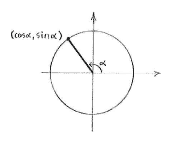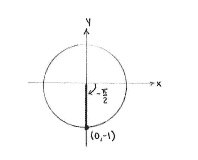Solution 4.2:3a
From Förberedande kurs i matematik 1
(Difference between revisions)
m (Lösning 4.2:3a moved to Solution 4.2:3a: Robot: moved page) |
m |
||
| (One intermediate revision not shown.) | |||
| Line 1: | Line 1: | ||
| - | + | A useful technique for calculating the value of a trigonometric function for angles that don't lie between <math>0</math> and <math>{\pi }/{2}\;</math> is to use the unit circle. If we draw a line which starts at the origin and makes a certain angle relative to the positive part of the ''x''-axis, we can see that the cosine of that angle is the ''x''-coordinate of the point of intersection between the line and the unit circle. In the same way, the sine of the angle is the ''y''-coordinate of the intersection point. | |
| - | < | + | |
| - | {{ | + | |
[[Image:4_2_3_a1.gif|center]] | [[Image:4_2_3_a1.gif|center]] | ||
| + | |||
| + | In this case, we see immediately that <math>\sin\Bigl(-\frac{\pi}{2}\Bigr) = -1\,</math>. | ||
| + | |||
[[Image:4_2_3_a2.gif|center]] | [[Image:4_2_3_a2.gif|center]] | ||
Current revision
A useful technique for calculating the value of a trigonometric function for angles that don't lie between \displaystyle 0 and \displaystyle {\pi }/{2}\; is to use the unit circle. If we draw a line which starts at the origin and makes a certain angle relative to the positive part of the x-axis, we can see that the cosine of that angle is the x-coordinate of the point of intersection between the line and the unit circle. In the same way, the sine of the angle is the y-coordinate of the intersection point.
In this case, we see immediately that \displaystyle \sin\Bigl(-\frac{\pi}{2}\Bigr) = -1\,.


